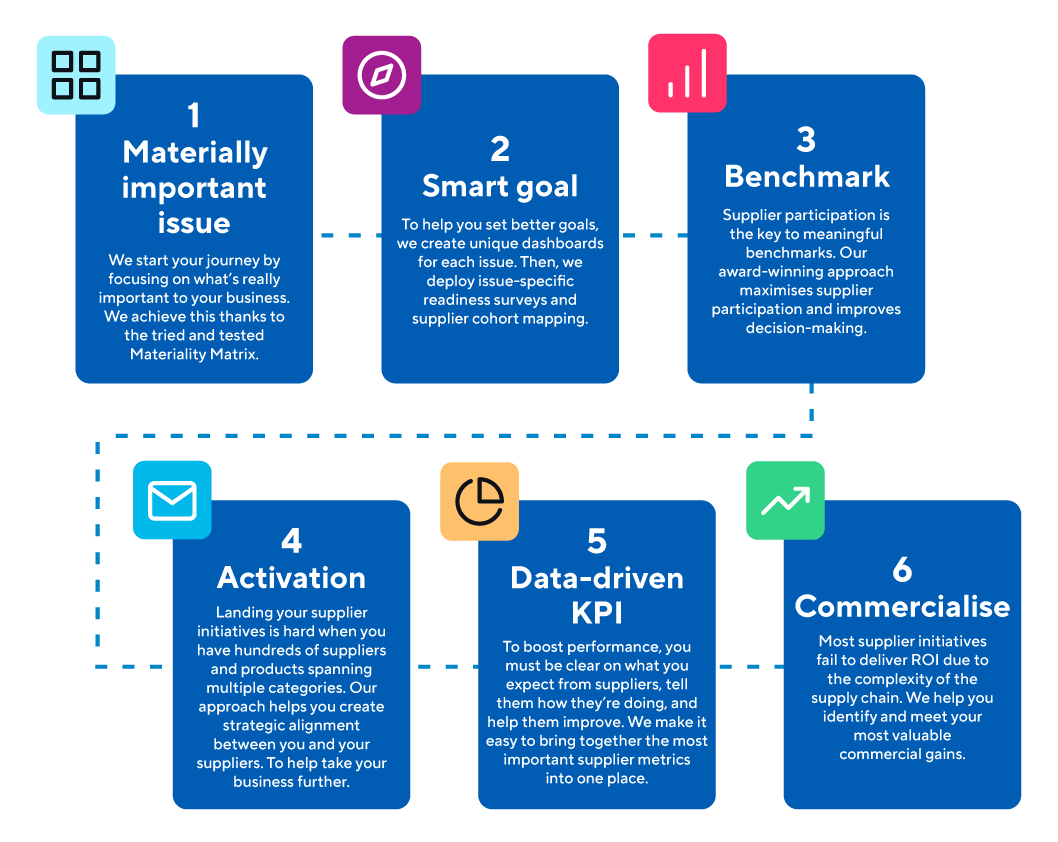Navigation:
What is supplier engagement?
Imagine if every single one of your suppliers were to pledge their energy, focus, and expertise to you, your brand, and your goals. This is supplier engagement.
Included in this guide
This guide has been designed for anybody trying to work more effectively with suppliers.
What is supplier engagement?
The simplest way to define supplier engagement is to think of it as a pledge or commitment; it is the level of commitment a supplier has to your brand, your values, and your goals. Suppliers focus their energy and expertise to not just support but drive progress towards your brand’s goals.
To enable this level of commitment and focus from your supply base requires dedicated and proactive communication with your suppliers. This means you need a strategy.
What is a supplier engagement strategy?
A supplier engagement strategy is a focused and proactive effort that aligns with wider business objectives and initiatives to add more value to the way you work with your suppliers.
It is likely you are already engaging suppliers, albeit not as successfully as you could be. A strong engagement strategy takes into consideration the dozens of interactions you have with your suppliers every day which could be more efficient, effective, and valuable. As a result, your suppliers are more aligned and committed to your goals.
Strategy vs tactics
An effective supplier engagement strategy will always have a material issue or priority focus, and will follow a Six-Step Process to achieve a specific, measurable, achievable, relevant, and timebound goal.
The tactics you apply within your overarching engagement strategy are what help you get to your goal and determine the strategy’s success. Learn more about supplier engagement tactics.
Why is supplier engagement important?
Here is the secret: the principles of supplier engagement are nothing new. After all, people are people - whether they are your employees or the employees of your suppliers.
Supplier engagement has the potential to either bring you closer to your goals much faster, or hinder progress – depending on whether you decide to focus on it or not.
| Unfocused and passive supplier engagement | Successful and proactive supplier engagement |
|
|
|
|
|
|
Every interaction you have with your suppliers has an impact on the relationship you have with them. Communicating with and supporting suppliers at every opportunity will cultivate new levels of motivation and understanding about your brand and its priorities.
What is the difference between supplier engagement and supplier relationship management (SRM)?
Both SRM and supplier engagement are aligned in their approach and purpose at a high-level. They are both strategic, interaction-oriented, and focus on maximising value.
| Supplier relationship management (SRM) |
| Supplier relationship management (SRM) relates to the performance of processes and systems within the procurement and sourcing functions. It also focuses on a few key strategic relationships within the supply base. |
| Supplier engagement |
| Supplier engagement is about purpose, motivation, and understanding; it makes suppliers care and want to collaborate to drive performance. It prioritises segments of the supply base by what is important to an immediate initiative or project. However, more often than not, supplier engagement focuses on the majority of suppliers rather than just the strategic ones. |
It is not a case of which methodology is better. Beyond the shared goal of maximising and unlocking value, they simply address different problems. They can (and do) live happily side by side.
However, if you want any supplier-related projects or processes to take less time, consume less of your valuable resource, and reduce the burden that comes with having a large supply base, then supplier engagement is what you are after.
Enhance your existing strategy
How to scale up your supplier engagement activities
Supplier engagement enhances your existing strategy - rather than replacing it – by building on some of the activities you already do.
Whether the goal of your strategy is to get products on the shelf faster, implement a new software system your suppliers will need to use, or reduce the emissions across your entire supply chain, you need to interact with all your suppliers. With a large supply base, you need these interactions to be efficient, of high quality, and aligned to your goals – otherwise you waste precious time and resources.
| 80% of strategies fail due to lack of a clear vision, supplier activation plan, and sustained engagement. |
You need to make your suppliers care about what you are trying to achieve – bring them all along on the journey. Without the capability to do this, any project or initiative involving suppliers (however many of them) is likely to fail.
How can supplier engagement be improved?
Motivate suppliers and they will complete a project quicker; grow their understanding and they will complete it to a high standard. This is easily done with a supplier engagement model.
| What is a supplier engagement model? |
| A successful supplier engagement model is a way of working with suppliers to boost supplier motivation and understanding of a specific brand goal, and ultimately drive progress and performance. |
The six-step process

Woven into the Six-Step Process are three key pillars (or tools): communication, support, and transparency. Whatever the size of your supply base, you need aligned and activated supplier contacts with whom you can share a clear vision or goal, and thus empower to help close any gaps in performance or progression against that goal.
| . | Communication | Support | Transparency |
| . | When Provide a timeline for the project/initiative/strategy Why Share why this initiative is important to your brand (and therefore your suppliers) and why the deadline needs to be met. What Clearly define what requirements and actions need to be taken by suppliers How Monitor how suppliers are progressing against your expectations and hold them accountable |
Empower suppliers Accompany all interactions around the initiative with links to resources and guidance. This will help suppliers work faster and to a much higher standard. Cultivate innovation Supporting your suppliers at every opportunity increases the likelihood that they will choose to bring their ideas and innovations to you. |
Set clear expectations Share performance with suppliers and schedule automatic updates when they approach deadlines. Recognise effort and achievement Let suppliers know how they are performing against your expectations. Enabling suppliers to monitor, analyse, and improve their performance makes their experience of working with you more rewarding. |
Is investing in supplier engagement worth it?
Businesses can have a 24x greater impact by collaborating with suppliers. This could be within the context of environmental, social, or competitive performance. Investing in supplier engagement is a no-brainer, especially considering that the cost of ineffective and inefficient supplier engagement is estimated to be in the millions (£)*.
Transform your suppliers into your greatest brand asset
- Increase the speed and accuracy of supplier responses
- Increase the number of proactive suggestions for improvements from suppliers
- Increase the amount of value-add work done by your team
- Activate suppliers in a way which serves your brand goals
- Provide a clear brand vision to suppliers
- Leverage expertise from within the supply base
- Get products on shelves quicker
- Get a higher percentage of suppliers ‘going the extra mile’
- Become customer of choice to your suppliers
- Achieve your ESG goals much faster
Supply Pilot can help you create and deliver your supplier engagement strategy.
Kickstart your supplier engagement strategy
What are some effective supplier engagement tactics?
Communicate in a personable manner.
Because communication is what glues everything together in effective supplier engagement, how you decide to communicate is crucial. It is important to remember that behind the brand names of your supplier contacts, there is a person. This means that whenever you or your team communicate with suppliers, remember to be respectful, conversational, and human.
Target your audience.
Whenever you send an email, there is always the risk it remains unopened (or worse, gets deleted before being opened). This risk increases if you do not properly tailor your supplier communications to specific cohorts of your supply base. These cohorts (or segments) could be defined by job role/responsibility, product category / business unit, or level of topical maturity around a certain initiative or goal you have.
For example, for an initiative around Scope 3 supply chain emissions, you will want to communicate differently with suppliers who are very new to the concept of collecting emissions data compared with those who are much more mature and already able to provide accurate data. The more relevant the content you send is to the supplier, the more likely they are to open and read it. Sending seemingly irrelevant content to suppliers can also damage your brand reputation.
Create the perfect subject line to your emails.
Restrain from telling suppliers how urgent something is in the subject line of your email – lines like these can tarnish your reputation. Instead, think carefully about what exactly you need suppliers to do, or what information you are sharing, and try to convey that in one sentence. This way, you have a clear and concise subject line which enables suppliers to immediately understand what you need from them without opening your email. This style of subject line can double opening rates, which translates to dozens of suppliers no longer needing to be chased.
Keep it short, sweet, and to the point.
Your suppliers are busy people; they do not want to read any more words than they absolutely need to. That also leaves no room for jargon – the easier you make your emails to read, the more likely it is your request will be done. For guidance, keep to three short paragraphs:
-
What is the context?
-
What do you need them to do? (link to any resource or guidance on how to do it)
-
Who do they contact if they have a question?
We live in a world of stimulating and engaging content, so remember to also add some personality to your emails to make it a more pleasant read.
Just like everything else, track performance.
Every email has a goal. If your emails are not being opened or read, then your goal will become more difficult to achieve. You need to track whether each supplier has 1) received, 2) opened, and 3) completed the action requested within the email. This level of visibility enables you to target your energy based upon what suppliers are actually doing (or not doing).
Link the why to the what.
Our brains naturally seek to find patterns and order. You can maximise supplier understanding, alignment, and engagement by providing a structure for people to make sense of what you are asking them to do. This way, you are creating a relationship between the different components of your strategy.
-
Why does this matter to them? (the strategic narrative)
-
How do the initiatives fit together? (programmes of work)
-
What is needed and by when? (call to action)
Maximize the quality of supply chain data collection
Getting accurate and complete data from suppliers can remain a hurdle for many businesses. Nurturing suppliers throughout the any data collection initiative is what will help you get the highest quality (and most complete) data. This can be achieved by thinking about any obstacles a supplier might face along the journey.
7 steps of a supplier assault course
Consider your task from a supplier’s perspective. What specific actions do they need to take? Let us think of a data collection project as having four key stages: 1) the correct supplier contact receives the survey in their inbox, 2) they open the survey, 3) they start the survey, and 4) they complete the entire survey.
Consider what obstacles might stop a supplier from completing each stage. It might be that the supplier recipient does not understand the subject matter and deems your email irrelevant.
Some obstacles are quickly resolved, whilst others take long-term focus and management to improve. It could be as simple as making sure your instructions are clear and making sure you have the right email addresses for supplier contacts. Recognise the importance of these small steps.
By now, you will have identified the steps and obstacles that suppliers might face getting to this stage. You have successfully provided the requisite tools and knowledge that suppliers need to complete your data collection survey. But the journey does not end here.
You must continually review your suppliers’ progress, and consider that you might not have identified or anticipated all the obstacles at the beginning of the process – some may crop up at any of the different stages. Assigning key performance indicators (KPIs) to each stage will enable you to review your suppliers’ progress and tailor how you can help them move along to the next stage.
Once you have reviewed and understood your suppliers’ progress, you can address any new or existing obstacles you need to resolve.
All tasks, projects, or initiatives are unique and will have different stages that suppliers need to go through, and therefore different obstacles for you to identify and resolve. Stick to this assault course method for any forthcoming projects and you will notice the quality of supplier data increase.
Supplier self-help
What is supplier self-help?
Another powerful tool within the realm of supplier engagement is supplier self-help. It enables you to increase and improve the support you give suppliers without using any more resource, thereby reducing the amount of low-value repetitive queries your team need to answer.
Develop a supplier knowledge base
Supplier self-help usually comes in the form of one central resource platform (or knowledge base) which suppliers can easily navigate and digest all the background information they need about your project or initiative. It can be the difference between suppliers being aligned to your goal versus actually understanding what actions they need to take (and why).
Why do you need supplier self-help?
- Save £100k a year by diverting queries away from your team.
- Deliver consistent supplier management – your policies and processes are more likely to be applied consistently across your supply chain, regardless of category or team.
- Deliver scalable supplier development – a self-help platform is a flexible, scalable, and affordable options to develop your supply base
- Reduce risk by identifying knowledge gaps early – gain visibility of what suppliers are searching for, what content they are reading, and easily spot any serious knowledge gaps which could risk legal, social, or environmental compliance.
- Enhance your suppliers’ experience and become their partner of choice – self-help fosters much more collaborative and productive relationships between you and your suppliers.
How to optimise supplier self-help
Break your materials into small answers around a paragraph or two long
Ensure your suppliers use your knowledge base by making it suit the way they like to search for information
People learn in different ways – your knowledge base needs to reflect that by using different types of content
Often an answer will lead to another question – pre-empt that and link relevant answers together.
Enable suppliers to search by category, or limit each supplier’s access to information which is only relevant to them.
Giving suppliers an easy way to give feedback within the knowledge base enables you to see gaps or improve answers
Consistently reinforce where the information suppliers need is. This way you can drive consistent supplier traffic to your knowledge base.
Optimisation can take time and valuable resource from your team. Supply Pilot's campaign team can alleviate that burden and help build this out for you.
Waitrose & Partners supports compliance for local and regional suppliers
Compliance was ensured across 650 suppliers and 1500 products via proactive supplier communications and supplier self-help content.


Woolworths and Supply Pilot collaborate on supplier engagement for country of origin
500 suppliers were aligned to the strategic goal to get country of origin data for over 25,000 products.


Walmart removes 20 million metric tons of GHGs from its global supply chain
Targeted email communications were sent to suppliers based on how far they had progressed towards completing the GHG survey


Pet supplies retailer achieves 6.5x increase in supplier activation and system adoption
A retailer of pet supplies partnered with Supply Pilot to boost adoption of their product lifecycle management system by suppliers, and in turn help to ensure high quality and safe products.

Supplier portal
An online supplier portal enables users to securely access functionality wherever they are in the world at any time, providing they have an internet connection. The Supply Pilot Platform is tailored to your organisation, using your logos and primary brand colour.
Supplier communications management
Measure and improve supplier contact accuracy with both administrative and supplier facing dashboards, scorecards, alongside automated supplier chasing and data maintenance reminders. This can be achieved by making sure your email communications are targeted and engaging for your supplier contacts.
Supplier knowledge base management
Creating informative and digestible knowledge base content will help suppliers get all the information they need independently (therefore freeing up your teams’ inboxes).
Supplier query management
Consolidate responses from suppliers into a single and reportable inbox. This way, it is much easier to identify knowledge gaps and potential risk.
Supplier action plans
Supplier action plans are a shared task list which enables you to collaborate with suppliers on innovation, corrective actions, or continuous improvement. Suppliers have clear expectations set, whilst businesses can hold their suppliers accountable to commitments made.
Supplier forms
Create data collection forms to suit almost any requirement at supplier and product level, targeting forms to specific sections of the supply base to ensure relevant data capture. Save suppliers time by enabling them to build libraries of commonly recurring data and copy their responses across from one form to another, whilst also embed contextual guidance within forms to help suppliers complete the data collection surveys.
Wondering how to get started with effective supplier engagement?
Committed suppliers who are aligned to your brand goals is not something to pass off lightly. Our platform and approach will help you move at pace and scale, whilst strengthening the relationships you have with suppliers - to ultimately deliver results.

